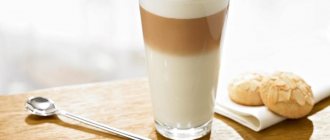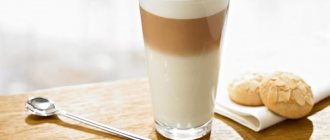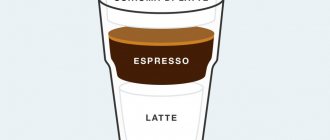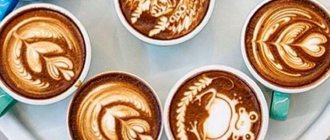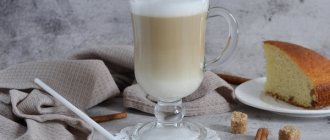Latte is a popular drink that is on the menu of every coffee shop. Many people like the bright, unique aroma and combination of taste of fresh natural milk and coffee. It is served in glasses, decorated with whipped foam, grated chocolate and nut crumbs. There are several types of latte glassware.
What is the correct name for a latte glass?
A specific name is not given, since even the origin of the drink is not entirely accurate. Moreover, various types of containers are used for serving coffee:
Fans of coffee cocktails love lattes for their large volume, low strength, soft creamy taste and the opportunity to experiment with toppings.
Each of them allows the barista’s imagination to run wild and surprise the client with something unusual.
There are several types of dishes to serve this drink - a cup, a glass and a latte glass.
Why are lattes served in special glasses?
Unfortunately, there are too many inaccuracies to answer the question about the origin of serving this coffee drink. The name deserves special attention - “Latte” - in Italy this was the name for milk served in tall glass glasses. Coffee itself is now served in the same way. Further, according to the history of the drink, they began to add a portion of espresso to the latte milk (instead of topping), and this is how this type of coffee turned out. However, in its homeland it is called latte macchiato or coffee milk translated into Russian.
As with many coffee stories and recipes, the origins and presentation of the latte have many inaccuracies.
Foam appeared even later - with the advent of cappuccino makers. Initially there was none.
Latte is Italian for milk, served in tall glass glasses.
Additional information: baristas quickly noticed that when pouring coffee into milk after whipping the foam, the latter remained under it. Thanks to this, the drink acquired the form known to all of us.
Today, latte macchiato glasses are a pleasant continuation of the traditions of the past. Preference is given to clearly distinguishable layers - aesthetically it looks much more beautiful, especially if the drink is additionally sprinkled with chocolate chips or cinnamon.
Baristas noted that if a shot of espresso is poured into milk in a special way immediately after whipping, the coffee gets under the light and loose foam, forming a dark layer.
Volumes of coffee cups
In many coffee shops, visitors are faced with the problem of determining the serving size of a particular type of coffee. How much is a cup of coffee? After all, there are many coffee-based drinks, and for each type the portion dosage is individual.
Main types:
- espresso - a basic variety with a rich, strong taste, usually 30-35 ml;
- Americano - espresso diluted with water to reduce strength, 180-200 ml;
- cappuccino – prepared with the addition of milk, serving size from 170 to 200 ml;
- latte - the cocktail is prepared with the addition of at least 150 ml of milk, the serving is 200-250 ml;
- Oriental coffee - brewed in small portions of 60-70 ml.
Considering the volume of the finished product, the dishes for it need to be selected with a reserve. Accordingly, cups for coffee drinks should be slightly larger than the serving size. In doing so, they must retain the warmth of the liquid and show off the beauty of the cocktails when layered.
The coffee cup should keep the drink warm
For espresso
The basic coffee drink is brewed in a small volume, so the cup for it is chosen to be small - 35-40 ml, sometimes 50-70 ml. A suitable option is a demitasse bowl in the shape of an inverted truncated cone, designed for 60-90 ml. The main task of such dishes is to maintain the high temperature of the liquid for as long as possible. Therefore, its walls should be thick, and the cup itself should be made of porcelain or ceramics. Glass gives off heat faster, unless, of course, it is multi-layered.
A mandatory element of the mug design is the handle. Since the espresso must be hot, holding on to the sides is not always convenient or safe. An acceptable alternative is rubberized inserts, but this appearance does not suit everyone, since it corresponds to the classic idea of \u200b\u200bthe drink.
Currently, coffee shops use 90 ml containers. It is convenient because it is suitable not only for espresso, but also for types of coffee based on it: lungo, ristretto.
For Americano
Diluted espresso is usually served in a 200-220 ml container. As a rule, these are standard white porcelain or ceramic cups. As an exception, cappuccino glasses that match the milliliter size can be used. The Americano recipe requires using at least 180 ml of water. Ground coffee is added to it and boiled until done. Etiquette does not allow serving a drink in a mug filled to the brim. Therefore, the container should be 20-30 ml larger than the finished portion.
For cappuccino
Cappuccino is a coffee cocktail with the addition of milk and high milk foam. To serve it, glass glasses with a volume of 170-220 ml are used. According to etiquette, the drink is served poured to the edge of the cup; the foam may rise slightly above it. A classic cappuccino is prepared using espresso with the addition of milk and thick milk foam. The proportions of the ingredients are 2:1, so the dishes should be spacious enough.
Cappuccino glasses of 170-220 ml are considered universal, since they can serve various types of coffee and milkshakes: lungo, dopio, espresso with cream, etc.
Some cups are meant to convey the color and layers of the drink
For latte
Making a latte involves adding coffee and a large amount of milk, at least 150 ml. Accordingly, the volume of dishes for it should be larger than for other types of drinks. Glasses come in sizes 250, 300 and 360 ml. Similar containers are used to serve Frappuccino, a cocktail that also requires a large amount of milk to prepare. The finished portion can reach 350, 400 and even 500 ml. Serve latte and frappuccino, filling the glass to the brim. It is advisable that the foam does not protrude beyond the edges, especially if something is drawn on it (a popular trend when serving lattes lately). Otherwise, the design will quickly become distorted, since the foam “cap” will not be able to hold its shape for long.
For oriental coffee
When trying this type of drink for the first time, not many people understand how many ml a coffee cup will contain in the end. Oriental coffee is brewed in small quantities with large amounts of caffeine, rich taste and aroma. Therefore, the cups are selected small, with a volume of 70-90 ml. Certain types of drinks brewed in Turk are drunk in tiny portions. In this case, you can use a 50 ml mug. Demitasse tableware is considered an excellent option. Its shape helps to maintain the temperature of the liquid, all the taste and aroma of coffee for a long time.
Why do you need a DeLonghi glass?
DeLonghi glasses are distinguished by the presence of double glass, so even drinking fairly hot espresso will not cause discomfort. We're not talking about latte at all.
Luxurious, spacious and branded - that's what they are all about.
The glass can also accommodate double espresso; larger models are rarely found.
Espresso glasses are commonly referred to as double-walled glass containers.
Types of tableware for latte coffee
Thanks to the human desire to stand out, not only different serving methods, but also types of containers began to be used for the drink. Each of them opens up new scope to surprise the client.
Over time, other interesting serving options for this recipe have appeared.
Drawing, topping, topping, natural berries - these are just the bare minimum of design elements for this coffee.
The choice of glassware for drinking it depends on the type of drink and your preferences.
Latte glass
One of the classic options most often found in establishments. The volume depends on the personal wishes of the client or is set in the menu. From 150 to 300 milliliters (standard).
Made of glass, has a volume from 150 to 300 ml, equipped with a handle.
There are two types of glasses:
On a short stem, similar to an enlarged glass and a regular one, reminiscent of a glass cup. All coffee glasses are transparent. The drinker should see smooth transitions from milky white to coffee brown and back.
Latte glass
The main difference from the previous type of container is the absence of a handle. Volume 250-300 milliliters. Often served on a saucer.
It is distinguished by the absence of a handle. Its volume ranges from 250 to 300 ml.
Latte cup
A cup is a separate type of tableware. Laconic inverted trapezoid shape, comfortable handle. Opaque. Preference for cup colors is white, cream and vanilla.
Most often it has the classic colors of coffee utensils - white, cream, vanilla.
Often sold complete with a small saucer and small spoon. Volume up to 320 milliliters, larger specimens are rarely found.
Latte mug
Thick-walled porcelain or ceramics are the main materials used in the manufacture of mugs. Quite heavy, somewhat rough for a delicate drink, which partly complements it.
Latte mugs can be straight-sided or tapered at the bottom.
It is distinguished by increased reliability and some comfort created by peace of mind.
Latte glass - main characteristics
This type of tableware has gained immense popularity due to its democratic nature. It can be made from plastic, ceramics, porcelain, glass. Glasses often have an expressive design. Bright colors, fashionable designs, stylish prints make them popular among young people. Despite the apparent diversity, all representatives of this class have common features.
- Large volume. A latte glass can be up to 360 ml; popular options are 250-330 ml.
- The shape is an inverted trapezoid or an inverted bell.
- Price. Depends on the material of manufacture, design and the manufacturer himself. Thus, a plastic glass from the German manufacturer Lurch costs from 350 rubles. Porcelain with silicone inserts from the Danish company Eva Solo will cost 1,500 thousand, and ceramic from the Chinese Sagaform complete with a special spoon has a price of 900 rubles.
How to choose latte glassware
The correct choice of glassware for drinking a particular drink is of certain importance. So, giving preference to a glass, mug or cup, you should understand the following:
- they have different characteristics;
- has its own characteristics;
- different taste of the drink.
Most rely on aesthetic pleasure. After all, drinking a coffee drink is much more pleasant, at least from a mug with the inscription “Coffee”.
The real taste of latte macchiato is revealed only when the drink is smooth.
It is important to know: even in professional establishments, transparent containers are gradually fading into the background; tall cups and mugs are becoming more and more common.
Why? Everything is extremely simple!
- The revelation of real, full taste and aroma is possible when the drink reaches a homogeneous mass. The barista should pour the espresso in such a way that the mixing is maximum.
Glass is inferior to opaque materials due to the immediate loss of aesthetic appearance.
- Porcelain retains the original temperature of the drink much longer, which is important for establishments. Therefore, preference is increasingly given to thick-walled cups and mugs.
- The versatility of ceramic mugs. Suitable for tea, Americano, latte and other drinks.
Thus, transparent coffee glasses are gradually beginning to lose their former popularity. Establishments want to optimize costs, customers of coffee shops and cafes want to get maximum pleasure from drinking a coffee drink.
At the barista championship, lattes are evaluated, among other things, by the uniformity of taste. The layered structure is considered bad form for connoisseurs.
Choosing the volume of a coffee cup for your home, office or coffee shop
During the day we have to go to different places. It's nice to have a cup of coffee at home, at work or in a cafe. The right utensils will help you enjoy your favorite ritual.
For home
Choosing a container for home use is, of course, a personal matter. Each person has their own vision of ideal tableware. In most cases, a coffee cup with a capacity of 160-180 ml will be a universal option. This way you can easily enjoy your favorite type of coffee drink.
For a coffee shop
If we are talking about choosing tableware for a coffee shop, then you will need 3 types of cups.
- Small cups for espresso or macchiato, capacity 70-90 ml.
- More voluminous mugs, designed for 180-220 ml. Used for Americano or cappuccino.
- Glasses for coffee cocktails, holding 280-360 ml of drink.
